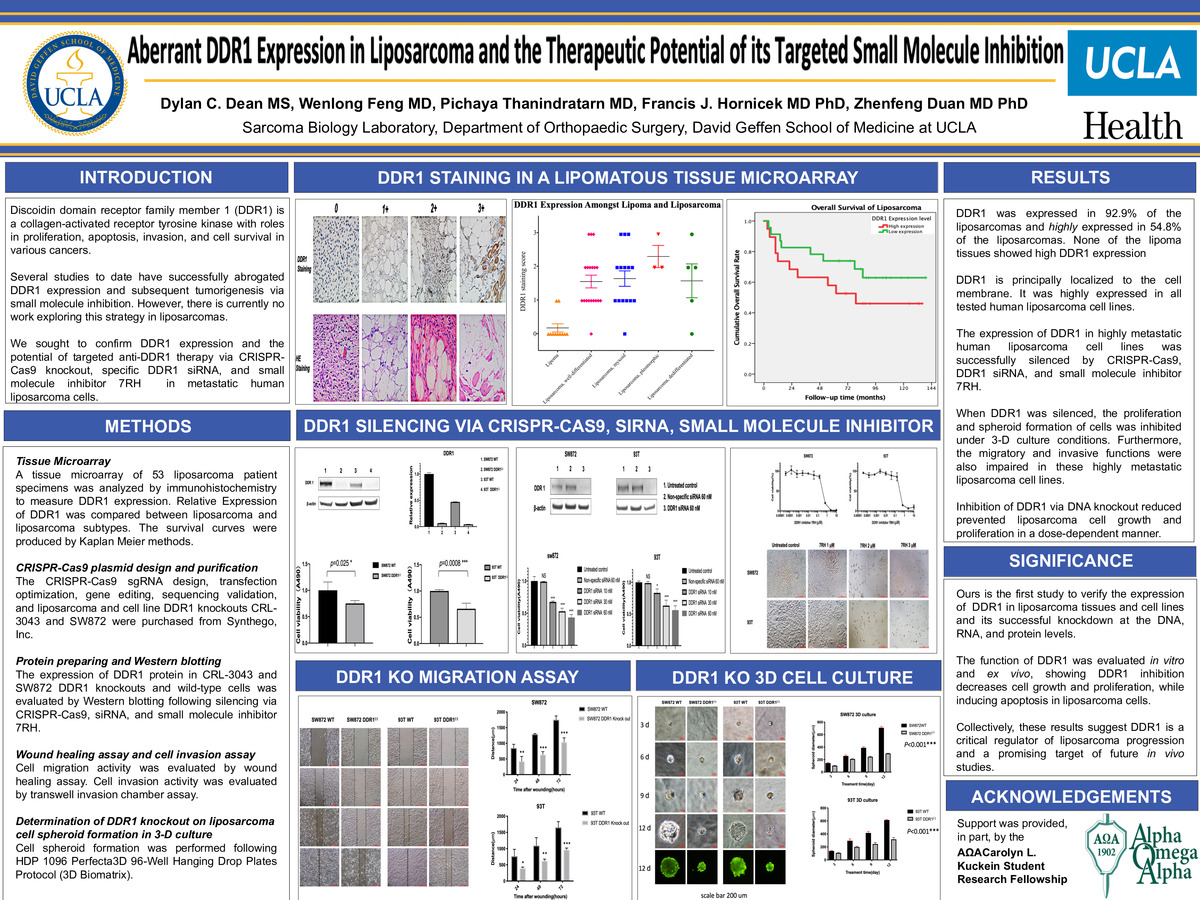-
Author
Dylan Dean -
Co-author
Wenlong Feng MD, Pichaya Thanindratarn MD, Francis J. Hornicek MD PhD, Zhenfeng Duan MD PhD
-
Title
Aberrant DDR1 Expression in Liposarcoma and the Therapeutic Potential of its Targeted Small Molecule Inhibition
-
Abstract
Aberrant DDR1 Expression in Liposarcoma and the Therapeutic Potential of its Targeted Small Molecule Inhibition
INTRODUCTION: Liposarcoma is the second most common soft tissue malignancy, accounting for 15% of all adult soft tissue sarcomas. Although the incorporation of novel neo-adjuvant chemotherapeutics has been a major goal of clinical sarcoma research, the use of chemotherapy in liposarcomas remains controversial, and not much progress has been made in improving liposarcoma survival rates within the past 20 years. Discoidin domain receptor family member 1 (DDR1) is a collagen-activated receptor tyrosine kinase with roles in proliferation, apoptosis, invasion, and cell survival in various cancers. Several studies to date have successfully abrogated DDR1 expression and subsequent tumorigenesis via small molecule inhibition. However, there is currently no work exploring this strategy in liposarcomas. In this study, we investigate DDR1 expression and targeted anti-DDR1 therapy via CRISPR-Cas9 knockout, siRNA transfection, and via the small molecule inhibitor 7RH in highly metastatic human liposarcoma cells.
METHODS: The expression of DDR1 was tested in liposarcoma cell lines via Western blot. Expression of DDR1 was further validated by immunohistochemistry in a 54 patient liposarcoma tissue microarray to analyze its relationship with clinicopathological characteristics. The effects and underlying mechanisms of DDR1 inhibition were evaluated with DDR1 siRNA, DDR1 inhibitor, and DDR1 CRISPR-Cas9 knockout cell lines. Cell proliferation and cytotoxicity of DDR1 inhibition were assessed by MTT and clonogenic assays. Western blotting was applied to investigate the mechanisms of DDR1 inhibition on transcription and apoptosis. The effect of DDR1 inhibition on liposarcoma cell motility was examined by a wound-healing assay.
CRISPR-Cas9 plasmid design and purification
The CRISPR-Cas9 sgRNA design, transfection optimization, gene editing, sequencing validation, and liposarcoma and cell line DDR1 knockouts CRL-3043 and SW872 were purchased from Synthego, Inc.Protein preparing and Western blotting
The expression of DDR1 protein in CRL-3043 and SW872 DDR1 knockouts and wild-type cells was evaluated by Western blotting after inoculation of DDR1 inhibitor and siRNA. Protein lysates were extracted using 1× RIPA Lysis Buffer (Upstate Biotechnology). Protein concentrations were determined by Protein Assay Reagents (Bio-Rad) and a SPECTRAmax Microplate Spectrophotometer from Molecular Devices. The primary antibodies for DDR1 (1:1000 dilution) were purchased from Cell Signaling TechnologyWound healing assay and cell invasion assay
Cell migration activity was evaluated by wound healing assay. Cell invasion activity was evaluated by transwell invasion chamber assay.Determination of DDR1 knockout, siRNA, and small molecule inhibition on spheroid formation in 3-Dimensional (3-D) culture of liposarcoma cells
Cell spheroid formation was performed following HDP 1096 Perfecta3D 96-Well Hanging Drop Plates Protocol (3D Biomatrix).Statistical analysis
GraphPad PRISM 5 software was used to statistically analyze the data. The differences between groups were also evaluated using the two-sided Student’s t- test. Errors were SD of averaged results and p values <0.05 were considered statistically significant between means, p values <0.01 were accepted as a significant difference between means.RESULTS SECTION: The expression of DDR1 in highly metastatic human liposarcoma cell lines was successfully silenced by CRISPR-Cas9, siRNA, and small molecule inhibitor 7RH. When DDR1 was silenced, the proliferation and spheroid formation of cells was inhibited under 3-D culture conditions. Furthermore, the migratory and invasive functions were also impaired in these highly metastatic liposarcoma cells. DDR1 is largely localized to the cell membrane of liposarcoma cells as seen in tissue microarray and is highly expressed in all tested liposarcoma cell lines and over 60% of human liposarcoma tissue microarray samples. Inhibition of DDR1, with either siRNA, DDR1 inhibitor, or DNA knockout, prevented liposarcoma cell growth and proliferation in a dose-dependent manner.
DISCUSSION: This is the first study to explore the role of DDR1 in liposarcomas. Our findings confirm DDR1 is expressed in liposarcoma. The function of DDR1 was evaluated in vitro and ex vivo, showing DDR1 inhibition decreases cell growth and proliferation, while inducing apoptosis in liposarcoma cells. Collectively, these results suggest DDR1 is a critical regulator of liposarcoma progression and a promising target of future in vivo studies. In addition, it may be an option for those patients with aggressive liposarcomas not amenable to full surgical resection or intolerant to commonly used cytotoxic chemotherapies.
SIGNIFICANCE/CLINICAL RELEVANCE: Given the limitations of current chemotherapeutics in unresectable and metastatic liposarcoma, developing more efficacious drugs for these patients is a primary goal of current liposarcoma research. By elucidating DDR1 expression and pro-tumorigenic effects of liposarcoma our lab, we are the first to have defined the mechanism, expression, and potential of targeted DDR1 inhibition as a novel liposarcoma therapy.
ACKNOWLEDGEMENTS: Supported in part by an Alpha Omega Alpha Carolyn L. Kuckein Student Research Fellowship
-
College
AAC
-
Zoom
-
PDF

